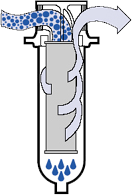How Does a Coalescing Filter Element Work?
Published by Filter Element Store on Feb 16, 2015
Compressed Air Coalescing Filter Elements

Our most popular coalescing filter elements separate water and oil from compressed air using a coalescing effect. When the air stream enters the coalescer filter housing, the water and oil droplets are knocked out of the air stream thanks to the design of the filter housing and the media used in the coalescing filter element. One of the more common filtration medias used for coalescing filter elements is Borosilicate glass microfiber.
What some people do not realize is that coalescing filter elements also remove solid particulate contamination! They provide a two-in-one knockout against liquid and solid contamination. Coalescing filters for compressed air typically remove 99.9% of 0.3 microns.
Oil and Gas Coalescing Filter Elements
For industries such as oil, gas, and petrochemical, Liquid / Gas coalescers are often used to remove water and other liquids down to 0.3 microns from natural gas. The liquid-gas coalescer filters keep natural gas quality high and protect downstream equipment such as expensive compressors, gas turbines, dryers and desiccant, and more. Some of these filters are actually separators and do not contain a filter element as they mechanically separate the liquids, but people still refer to them as filters.
Coalescing filters, or liquid-gas coalescers, are also used upstream to protect a compressor and downstream to recover lube oil from the compressor. The coalescer prior to the compressor removes water, aerosol, hydrocarbon liquids and more. These coalescing filters also remove 99.9% of 0.3 micron.
These are the two main types of coalescing filter elements that we have provided for nearly 40 years. If you need help with a coalescing filter application, please contact us so we can help.
